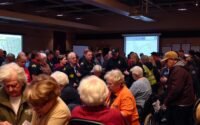Realistic Scenario Planning: Identify Local Risks
Can a simple household plan really cut chaos when an emergency hits? This article gives you clear, usable steps that move your family from uncertainty to action. You’ll learn an easy lens for spotting local hazards and choosing what matters most for your home and loved ones.
We blend plain risk analysis with proven steps: define core issues, rank drivers, build compact scenarios, pick triggers, and act. Each step is written for busy people who want practical results, not long theory.
Expect faster responses and calmer choices when you use this living guide. We update tools and templates often so your checklist and go-bag stay current with season and local changes.
Key Takeaways
- Small, repeatable steps help any household move from worry to readiness.
- Use simple analysis to spot early warning signs and trigger action.
- Focused scenarios beat vague plans—your family will respond better under stress.
- Printable templates and clear roles make tasks manageable for everyone.
- Regular updates keep guidance useful as hazards and seasons change.
Why Realistic Scenario Planning matters for your family right now
This article gives you a compact way to turn broad worry into a small set of clear actions your family can follow. A simple script helps everyone know what to do when alerts arrive.
From “anything can happen” to “we have a plan”
Start by mapping a few likely scenario outcomes for your area. That mapping shows impact, trigger signs, and quick mitigation steps. It keeps false confidence low by forcing choices before a crisis begins.
The benefits: agility, informed decisions, and better outcomes at home
Quick wins show up fast: less scrambling, faster coordination, and safer decisions when weather, air quality, or outages appear. Small practice runs build muscle memory and protect household health—kids, seniors, and pets especially.
“Good scenario work helps a household act quickly and confidently when minutes matter.”
- Clear roles so your family team moves without debate.
- Defined scenarios that let you pivot when forecasts change.
- Updated assumptions that improve outcomes over time.
| Area | Benefit | Impact |
|---|---|---|
| Household roles | Faster coordination | Reduced confusion |
| Simple scenarios | Clear decisions | Better outcomes |
| Adaptation rhythm | Continuous updates | Lower false confidence |
Bookmark this guide and revisit it often. The same ideas used in business work at home when you use plain language and family-sized steps. Your future readiness will improve with small, steady practice.
Realistic Scenario Planning: How to Identify Local Risks
Write one short purpose statement that keeps every decision focused on family safety.
Center your purpose: protect individuals and your household
Begin with a one-line mission: protect life, maintain health needs, and secure your home. This sentence guides every choice and keeps the plan clear for kids and elders.
Define local hazards using a simple PESTEL lens
Use PESTEL to list drivers: political (orders, school closures), economic (income shifts), social (community support), technological (utility outages or cyber threats), environmental (storms, air quality), and legal factors.
List assumptions and unknowns to reduce uncertainty
Write explicit assumptions (car available, cell service works) and unknowns (outage length). Clear assumptions make uncertainty visible and fixable.
Prioritize and map stakeholders
- Score each hazard by impact on health, probability, and warning time.
- Map stakeholders: family members, neighbors, schools, clinics.
- Document who owns updates and what data you refresh each season.
| Driver | Likelihood | Impact |
|---|---|---|
| Storms (environment) | Medium | High |
| Power outage (technology) | High | Medium |
| School closure (political) | Low | Medium |
Document decisions in a shared binder and notes app so your family can follow this step-by-step process and turn analysis into usable plans.
Use data, tools, and templates to ground your planning
Use trusted feeds and simple templates so your household bases decisions on current data.
Set up authoritative alerts now. Subscribe to NOAA watches and warnings, enable Wireless Emergency Alerts on phones, sign up for your state emergency portal texts, and get outage notices from power and water utilities.
Create a download-ready Household Risk Inventory that lists hazards, health needs, and critical devices like CPAP or refrigerated medicines. Keep a Neighborhood Map & Contact List that shows addresses, special needs, and nearby services such as urgent care and veterinarians.
https://www.youtube.com/watch?v=JkHOvJa4_hc
Keep a simple source log noting where each piece of information came from and when you last checked it. Store printed templates in a grab-and-go binder and mirrored copies in shared cloud notes for redundancy.
“Continuous, reliable data and frequent checks make your decisions faster and safer.”
- Test alert apps, weather radios, and battery packs monthly and record results.
- Apply light analysis: mark seasonal risks, short-warning hazards, and devices at greatest risk first.
- Assign a family owner for each template and refresh at the start of every season.
| Source | Use | Action |
|---|---|---|
| NOAA / NWS | Watches & warnings, air quality | Enable app alerts; check hourly during events |
| FEMA / Ready.gov | Preparedness checklists | Download templates; fill Household Risk Inventory |
| State emergency portal | Local advisories, shelter info | Subscribe to texts; map local services |
| Utility alerts | Outage and boil-water notices | Register account alerts; note backup options |
Bookmark this page and your templates. Regular checks and clear owners keep your planning process current and useful for real family outcomes.
Turn local risks into clear scenarios your family can act on
Make each high-priority hazard into a short home-ready script for quick action.
Convert each hazard into three cases: best-case (minor disruption), base-case (most likely), and worst-case (severe impact). Write them as short stories that place your family in a moment. Use plain details: where you are, what you see first, how fast conditions change, and your first 10 minutes of action.
Best‑/Base‑/Worst examples for U.S. events
Use concrete examples so the plan is easy to follow. For wildfire smoke, note AQI thresholds: 150 (best), 200 (base), 300 (worst). For a hurricane, map watch → warning → evacuation. For a ransomware hit, describe the pop-up, immediate isolation steps, and who calls IT or support.
Keep scenarios small and actionable
Limit your set to 5–7 scenarios. Fewer, well-practiced cases beat many unreadable ones. For each story, list assumptions and what breaks if they fail (roads closed, Wi‑Fi down). Mark decision points and backup options—alternate routes, second shelter, paper maps, or cash on hand.
| Scenario | Time Pressure | Key Assumption | Immediate Action (first 10 minutes) |
|---|---|---|---|
| Wildfire smoke | Hours | Roads open | Seal room, run HEPA; if AQI>300, relocate |
| Hurricane landfall | Days | Evacuation route clear | Load go-bags, confirm rendezvous point |
| Home ransomware | Minutes | Device isolated | Disconnect network, switch to backups |
Practice each story with short drills and label expected outcomes by time. That makes roles clear and your family faster when something real happens.
Pick early indicators and trigger points to know when to act
Set clear alert points so every family member knows when monitoring becomes action.
Choose practical indicators from trusted feeds: weather watches and warnings, AQI numbers, utility outage texts, and local news spikes. Match each feed to a short, plain rule your household understands.
Translate alerts into simple triggers. For example, a watch means prepare gear; a warning means follow the checklist now. Use measurable thresholds so decisions aren’t vague.
- AQI > 150: masks for sensitive people; > 200: seal a room and run HEPA; > 300: move to your clean-air site.
- Utility outage estimate > 8 hours: move meds to a cooler; > 24 hours: start generator plan or relocate.
- Proxy signals: sudden local news volume about boil-water orders or wildfire growth near your county.
Track readiness and recovery metrics. Leading indicators include charged battery banks, gallons of water, and offline backups. Lagging indicators record what you learn after an event: time to evacuate and time without power.
| Indicator | Trigger | Immediate response |
|---|---|---|
| Watch (weather) | Official watch issued | Stage go-bags, check phones |
| AQI | >150 / >200 / >300 | Masks → seal room → relocate |
| Outage | Estimated >8 hrs | Protect meds → conserve power |
Assign who monitors each feed (NOAA app, utility text, school emails). Put triggers on one page in your binder and on the fridge so anyone can act quickly if you’re away. This step makes your scenario planning work when time matters most.
Build prevention, response, and recovery plans for each scenario
Create clear, compact plans that spell out prevention steps, immediate actions, and recovery chores. Keep each plan one page so family members can read it fast. Use plain language and a single owner for updates.
Prevention strategies: mitigate health, safety, and cybersecurity risks
Prevention pages list simple steps: up-to-date vaccinations, N95 masks for smoke, shutoff valve locations, surge protectors, and patched devices. Add offline backups and phishing checks for your home network.
Response checklists: go-bags, routes, communications, and roles
Write who does what at 0–10 minutes, 10–30 minutes, and 30–120 minutes. Include evacuation routes, rally points, fuel minimums, and an out-of-area contact. Keep one-bag-per-person and a family tote; inspect quarterly.
Recovery actions: insurance, documentation, and service restoration
After an event, call insurance, take timestamped photos, and track expenses. List steps to restore power, water, and internet, and document data recovery from offline backups after a ransomware hit.
Family drills and wargaming: stress-test plans and find gaps
Run short drills: a late-night outage, a sudden AQI jump, or a blocked route. Time each step and note friction. Update the plan after each drill and measure improvements.

| Plan page | Key action | Owner | Readiness metric |
|---|---|---|---|
| Prevention | Stock masks, patch devices | Health lead | N95s on hand, backups verified |
| Response | Execute first 10-min checklist | Household captain | Minutes to car, charged phones |
| Recovery | Document damage, call insurer | Records keeper | Time to restore services |
| Drills | Run wargame, log lessons | Drill coordinator | Number of friction points fixed |
Keep roles clear so your team moves without debate. Use this simple process to improve readiness, measure results, and reduce risk over time.
Common pitfalls in scenario planning and how you avoid them
Many plans fail because they assume calm and ignore the messy realities that happen at night or during storms. That gap creates false confidence and slows your response when seconds count.
Overly narrow scenarios, stale data, and false confidence
A major pitfall is building scenarios that cover only ideal routes and normal hours. Include alternate routes, power and communications failures, and off-hours timing so your plan covers realistic uncertainty.
Old assumptions also create trouble. Don’t let contact lists or gear checks linger unverified. Validate information sources such as NOAA/NWS, utility dashboards, and county alerts so you act on facts, not rumors.
Keep plans current: review cadence, ownership, and version control
Set a simple review cadence: quarterly checks and a short “pre-storm” refresh when forecasts trend your way. Assign ownership so each task has a named person—one for contacts, one for gear, and one for documentation.
- Mark versions and dates on every checklist and archive old copies in your binder.
- Balance depth with simplicity: fewer, actionable scenarios beat a binder nobody reads.
- Schedule drills after quiet periods to avoid slipping into complacency.
- Keep a short “mistake log” page for near misses and lessons learned.
“Avoiding stale data and clear ownership is the single best step you can take to keep plans useful.”
| Challenge | Fix | Owner |
|---|---|---|
| Too-narrow stories | Add alternate routes & failures | Household captain |
| Stale information | Quarterly checks + pre-event refresh | Information lead |
| False confidence | Regular drills & mistake log | Drill coordinator |
Bookmark this guide and treat updates as part of daily household management. You’ll reduce uncertainty, improve response time, and keep your planning process ready when it matters most.
Quick-start guides, templates, and case examples
This section gives compact, ready-to-use templates that make rapid family decisions simple.
Step-by-step Planning Guide for households
Grab the household guide: write your purpose, list hazards with a PESTEL check, score by impact/probability/warning time, and pick your top 5–7 scenarios.
Scenario Builder Template
Use a four-column template: Hazards, Assumptions, Consequences, Actions. Add triggers, roles, and a sensitivity note for supply-chain style disruption.
Case examples
Each case uses best / base / worst structure and a short story format so your team can act fast.
- Wildfire smoke — best: short haze; base: AQI 200 for 24 hrs; worst: AQI 300+ multi-day. Actions: seal room, run HEPA, relocate if needed.
- Hurricane evacuation — best: voluntary early move; base: mandatory 24–36 hrs; worst: short-notice route closures. Actions: route options, fuel staging, rally points.
- Ransomware at home — best: single device isolated; base: network infected; worst: cloud backups targeted. Actions: disconnect, restore offline backups, reset passwords.
Options if primary actions fail: alternate shelter, second route, printed contacts, paper maps, and small cash. Keep one-page drill sheets and record data gaps after each run.
“Bookmark these tools and refresh them; small updates make plans reliable when minutes matter.”
| Template | Content | Owner | Readiness |
|---|---|---|---|
| Household Guide | Purpose, PESTEL, priorities | Household captain | Top 5–7 scenarios chosen |
| Builder Template | Hazards/Assumptions/Consequences/Actions | Information lead | Triggers & roles logged |
| Drill Sheet | One-page steps, timing, notes | Drill coordinator | Gaps logged & fixes set |
| Recovery Plan | Insurance, docs, restore steps | Records keeper | Contact list updated |
Conclusion
Finish by locking your choices into a short, usable plan your family can follow when events accelerate.
Good scenario planning aligns assumptions with driving factors, picks clear indicators and triggers, and uses short wargames to test readiness. Quantify a few readiness and recovery metrics so you know your current level and where effort yields the biggest impact.
Write simple actions and assign owners. That makes decisions faster and reduces hesitation. Capture consequences and lessons after each event and update plans regularly.
Bookmark this article and return for updated guides, templates, and local service pointers. Start small today; steady work raises your household’s resilience and gives you better outcomes for the people you love.
FAQ
What is the goal of household scenario planning?
The goal is to help you protect family members and household assets by turning uncertainty into clear, actionable plans. You focus on likely hazards, set trigger points, assign roles, and prepare resources so you can act quickly when events unfold.
Which local information sources should you check first?
Start with official alerts: NOAA for weather, FEMA for disaster guidance, state emergency management portals, and your utility provider for outages. Add local health department updates and community watch groups for neighborhood-level signals.
How do you choose which hazards matter most for your home?
Use a simple lens like PESTEL (political, economic, social, technological, environmental, legal) to list hazards. Then rate each by impact, probability, and warning time. Focus on the few with the highest combined score so your plans stay practical.
What does a basic household risk inventory include?
Include hazards, vulnerable people, critical systems (power, water, meds), key documents, and dependencies like childcare or caregivers. Note lead times, likely consequences, and short-term actions you can take to reduce harm.
How many scenarios should you write for your family?
Keep it small: three to five scenarios is usually enough — a best-case, a base-case, and a worst-case for the most relevant hazards. That keeps the team focused and makes drills realistic and repeatable.
How do you set trigger points so you know when to act?
Pick clear early indicators tied to reliable sources: watches and warnings, air quality index thresholds, outage durations, or official evacuation orders. Define when you move from monitoring to preparing to executing your plan.
What should be in a response checklist for a fast evacuation?
Include ready go-bags with meds, copies of IDs and insurance, a small cash stash, car fuel and keys, a preplanned route, and a communications plan that lists who calls whom and where you meet if separated.
How often should you update and test your plans?
Review plans at least twice a year and after major life changes (moves, new medical needs). Run short drills quarterly and a full wargame annually to test assumptions and improve response times.
How do you involve neighbors and local services in your planning?
Map stakeholders like nearby households, schools, and utilities. Share contact lists, agree on check-in roles, and coordinate resources such as sheltering space or shared equipment. Strong local ties speed response and recovery.
Can templates and tools make this easier?
Yes. Use household risk inventory templates, neighborhood maps with contacts, and scenario builder worksheets to capture hazards, assumptions, consequences, and actions. They save time and make plans consistent and transferable.
What common mistakes should you avoid?
Avoid overly narrow scenarios, stale data, and assuming signals will always be perfect. Don’t let plans gather dust: assign ownership, track versions, and keep sources current so your response stays effective.
How do you balance prevention, response, and recovery planning?
Allocate effort across all three: mitigation steps that reduce likelihood and impact, clear response roles and checklists for the event, and recovery actions like documentation, insurance claims, and service restoration to rebuild afterward.
How can you make plans easy for kids and seniors to follow?
Write short, plain-language steps and use visual cues like maps and color-coded lists. Practice drills with age-appropriate roles and keep important items in consistent, accessible locations.
What metrics help you know if your plan works?
Track response times in drills, completeness of go-bags, accuracy of contact lists, and whether you met trigger thresholds correctly. After an event, review outcomes, gaps, and lessons learned for the next revision.


